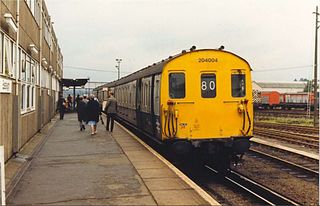
A diesel multiple unit or DMU is a multiple-unit train powered by on-board diesel engines. A DMU requires no separate locomotive, as the engines are incorporated into one or more of the carriages. Diesel-powered single-unit railcars are also generally classed as DMUs. Diesel-powered units may be further classified by their transmission type: diesel–mechanical DMMU, diesel–hydraulic DHMU, or diesel–electric DEMU.

The British Rail Class 108 diesel multiple units were built by BR Derby from 1958 to 1961, with a final production quantity of 333 vehicles.

The British Rail Class 121 is a single-car double-ended diesel multiple unit. 16 driving motor vehicles were built from 1960, numbered 55020–55035. These were supplemented by ten single-ended trailer vehicles, numbered 56280–56289. They have a top speed of 70 mph, with slam-doors, and vacuum brakes. The driving motor vehicles were nicknamed "Bubble Cars" by some enthusiasts.

The British Rail Class 116 diesel multiple units were built by BR Derby from 1957 to 1961. Introduced as part of the British Railways Modernisation Plan in the mid 1950s, as with other first generation DMUs the 116 was intended to replace steam trains and reduce costs across the rail network. Alongside Metro-Cammell, BR Derby had prior experience with DMUs, having developed a Lightweight Unit, and so was awarded a contract for a new design.

The British Rail Class 114 diesel multiple units were built by BR Derby from September 1956 to July 1957. Forty-nine 2-car units were built, numbered E50001-49 for driving motors and E56001-49 for driving trailers. The units were used in the early days out of 40A Lincoln TMD (LN) on services all over the county, although a small number were transferred to 41A Sheffield (Darnall) during 1959/60.

The British Rail Class 104 diesel multiple units were built by Birmingham Railway Carriage and Wagon Company from 1957 to 1959.

The British Rail Classes 101 and 102 diesel mechanical multiple units were built by Metro-Cammell at Washwood Heath in Birmingham, England from 1956 to 1959, following construction of a series of prototype units. These classes proved to be some of the most successful and longest-lived of BR's First Generation DMUs, second in longevity only to the Class 121, with the final five units being withdrawn on 24 December 2003. The oldest set was, by then, just over 47 years old.

The British Rail Class 127 diesel multiple units were built by BR Derby in 1959. Thirty 4-car units were built, formed of two outer driving motor vehicles, sandwiching two intermediate trailers which were classified class 186. The technical description of such as 4-car unit was DMBS + TSL + TS + DMBS.
The London, Midland and Scottish Railway (LMS) introduced a number of railcars to service between 1933 and 1939. Most were single units but one was a three-car articulated set.

The British Rail Class 204 designation has been used twice for two similar types of diesel-electric multiple units.

The British Rail Class 118 diesel multiple units were built by the Birmingham Railway Carriage and Wagon Company (BRCW) and introduced from 1960. It was a licence-built version of the British Rail Class 116.

The British Rail Class 201 six-car diesel-electric multiple units (DEMUs) were built in 1957–1958 at Eastleigh and underframes were built at Ashford.

The British Rail Class 155 is a diesel multiple unit passenger train. These DMUs were built by Leyland Bus at Workington between 1987 and 1988 as part of BR's replacement of its ageing first-generation diesel fleet. 42 units were originally built, of which only 7 remain; the other 35 units were converted to Class 153 railcars.

The British Rail Class 126 diesel multiple unit was built by BR Swindon Works in 1959/60 to work services from Glasgow to Ayrshire and comprised 22 3-car sets and were a development of the earlier Swindon-built trainsets that had been introduced in 1955 to work the Edinburgh Waverley - Glasgow Queen St services. These vehicles formed the first Inter City service to be operated by diesel units in Great Britain.

The Class 112 and Class 113 DMUs used the standard Cravens body used on Class 105s but had a single Rolls-Royce C8NFLH engine rated at 238 hp (177 kW) per car, all of which formed into 'power twins' – two car sets with both vehicles powered.

The British Rail Class 115 diesel multiple units were 41 high-density sets which operated the outer-suburban services from Marylebone usually to destinations such as High Wycombe, Aylesbury and Banbury which are on the Chiltern Main Line and Great Central Main Line. Sometimes, these sets used to operate 8- or 12-car-long expresses to Nottingham Victoria in the final years of the GCML. Coincidentally, Class 115 units operated services under Table 115 in the British Rail timetable.

The British Rail Class 140 was the prototype of the Pacer diesel multiple unit.

The British Rail Class 120 was a cross-country DMU in three-car formation, built at the British Rail Swindon Works.

The British Rail Class 124 diesel multiple units were built by BR Swindon Works in 1960.

Diesel multiple units and railcars are trains, usually with passenger accommodation, that do not require a locomotive. Railcars can be single cars, while in multiple units cars are marshalled together with a driving position either end. As of December 2010, 23 percent of the rail passenger cars used on Network Rail are part of a diesel multiple unit.






















